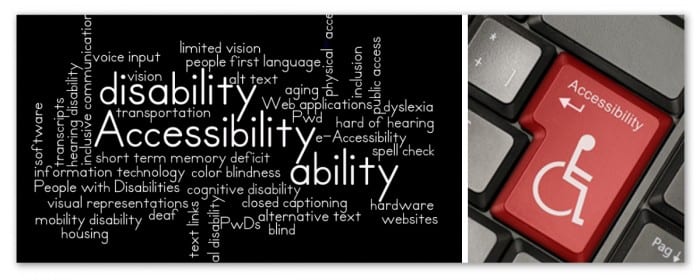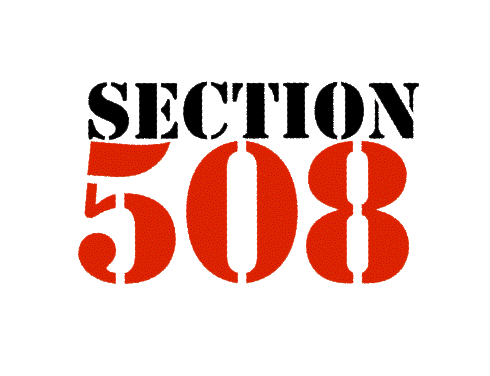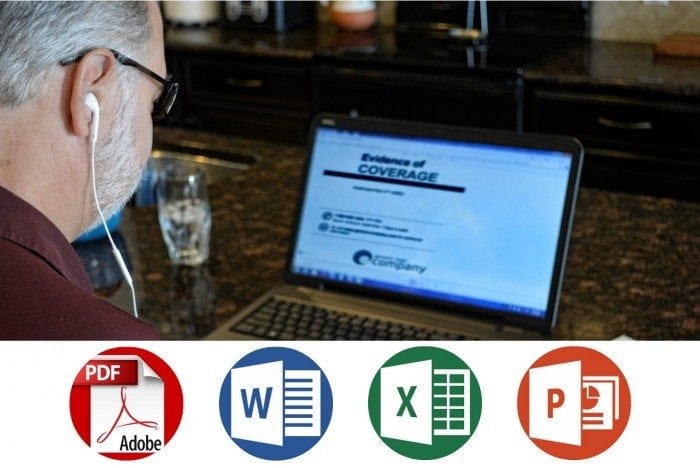Accessible Digital Documents
WHY Accessible Digital Documents are Needed
All public-facing documents available on the internet must be accessible to everyone. For all government agencies and companies that serve government agencies, supplying accessible digital documents is the law. People who have visual, cognitive, hearing or motor impairments have a difficult time accessing documents on the internet due to them being inaccessible. This means that people with certain disabilities can’t help themselves on the internet, preventing them from doing important things such as:
- Reading educational and training materials
- Accessing important documentation
- Submitting online employment applications
- Purchasing products and services

WHO Needs Accessible Documents?
As of 2019, an estimated 2.2 billion people worldwide have a visual impairment (Source: World Health Organization).
The following describes types of disabilities that impact the ability to read or consume incorrectly formatted documents:
Blindness
The inability to read online documents that are not formatted to meet accessibility compliance standards. To create accessible documents for people who are blind, ensure every online document file is formatted correctly so they can be accessed using screen readers. Screen reading software is a form of assistive technology that individuals with blindness use to identify and interpret what’s displayed on their electronic devices. Examples include JAWS by Freedom Scientific, TalkBack by Google, and VoiceOver by Apple.
Low Vision
The inability to read standard text. A number of factors cause low vision which means individual needs vary. Luckily, there are a few ways you can make your content accessible for people with low vision. Making your online documents accessible is a great place to start since many people with low vision also use assistive technology. Another important option is providing a way for visitors to resize the text on your website.
Color Blindness
The inability to read text that is in certain colors and fonts. When making documents accessible to people with low vision, use a 4.5:1 color-contrast ratio to ensure a screen magnifier can read the documents.
Other Visual Impairments
The inability to read certain font types or text that is displayed on backgrounds with heavy graphics. The accessibility solution for this is to only use font styles that are noted within the federal guidelines and avoid graphic-heavy backgrounds. Links to the specific guidelines are listed below.
Hearing Impairments
The inability to hear multimedia elements and videos embedded in PDF files. If transcripts and captions aren’t added, people who are deaf and/or deaf-blind will be excluded from accessing the information. Including synchronized captions and transcripts will ensure accessibility for the hearing impaired.
Cognitive Impairments
The inability to comprehend complex or hard-to-understand language within documents. To compose accessible documents for people with cognitive impairments, use simple language that is clear and well written. The easier it is to understand, the better. Some individuals who have cognitive impairments prefer to have content read to them using the same screen reading technology many people with visual disabilities use. That being said, documents should also be formatted so they are accessible to screen readers as well.
Motor Disabilities
The inability to access electronic documents using keyboards or other assistive technologies. Many people who have a motor disability can’t use a mouse to scroll or click on website navigation links, leaving them unable to operate dynamic elements effectively. Examples of motor disabilities include:
|
|
The solution here is to make sure all online documents are formatted correctly for accessibility so people with motor disabilities can easily access them by using keyboards, light signaler alerts, touch screens, and other assistive technology products.
WHAT are the Guidelines for Accessible Digital Documents?
The following guidelines were implemented so all public-facing documents and web content are accessible to everyone:




Section 508
Section 508 of the Rehabilitation Act of 1973 (amended in 1998 and codified in 29 U.S.C. 794d) is a federal law requiring all electronic and information technology (EIT) used by the government and organizations receiving federal funding to be accessible to people with disabilities. Technology that’s inaccessible hinders a person’s ability to locate and make use of information quickly and conveniently. Section 508 was put into place to break down the barriers in existing information technology, encourage the development of new technologies, and open the door to new opportunities for people with disabilities.
Specific Section 508 compliance requirements are maintained by the Access Board in the Electronic and Information Technology Accessibility Standards section (36 CFR 1194).
WCAG
The Web Content Accessibility Guidelines (WCAG) was created by World Wide Web Consortium (W3C) and covers a wide range of guidelines for making web content more accessible. October of 2023 brought the release of version 2.2. Version 3 is in its draft stage.
HHS
The United States Department of Health and Human Services (HHS) establishes policies and responsibilities for implementing Section 508 compliance. Originally implemented in 2011, these internal standards apply to web pages, applications, and all attached and downloadable files.
PDF/UA
Portable Document Format Universal Accessibility (PDF/UA) ISO 14289 is the standard for universally accessible PDF documents and forms. Compliance provides a top-quality reading and navigating experience for people using all types of confirming assistive technologies.
WHEN are Accessible Digital Documents Needed?
The simple answer is yesterday, today, tomorrow, and forever. People with disabilities should always have equal access to all information.
WHERE to Get Accessible Digital Documents for Your Business
If your company or organization needs to bring its’ online documents up to the latest compliance standards, you’re in the right place. Learn more about our 508 compliant document remediation services today and start providing your blind and visually impaired customers with the accessible documents they deserve.


